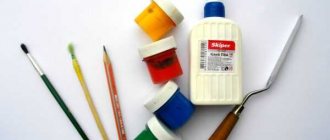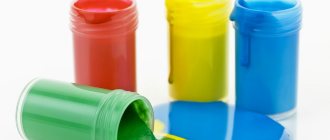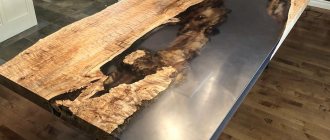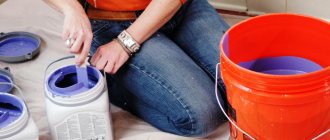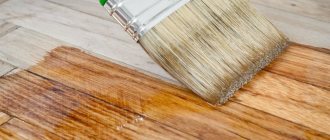Acrylic types of paints are popular; they are suitable for a variety of surfaces and can withstand a variety of impacts. But to strengthen the effect, as well as for additional shine, you can use varnishing of the layer. Not all beginners know which acrylic paint varnish should be used. The specifics of application and choice of product will be discussed in detail below.
Why do you need to varnish surfaces?
Applying varnish to a surface painted with acrylic paint may be advisable if it is wooden and susceptible to moisture. For example, a wooden table outdoors or any other wooden product intended for a room with high humidity (ground floor, basement, bathroom).
Moreover, wood is deformed under the influence of the environment. It may be susceptible to attack by pests.
And in order to avoid unpleasant surprises, it makes sense to protect wooden surfaces and products with additional protection.
Why do you need to cover gouache?
Works done in gouache are distinguished by their brightness and richness of colors. To preserve beauty, needlewomen strive to fix the paint. Processing is carried out in different ways for the following purposes:
- protect creativity from dust, dirt, light mechanical damage;
- strengthen the surface so that the color is not washed off with water (if it is a painted garden gnome, for example, and it is intended for the street);
- fixing color brightness.
Attention! Additional coverage is especially important if the item will be used - outdoors, in the kitchen, or under any thermal or water influences. Including if the painting is planned to be hung on a sunny wall.
Classification by type of varnish
- Varnish for application on acrylic paint. This type of varnish is non-toxic and therefore safe. Suitable for indoor use. Colorless and quick-drying material.
- Varnish based on cellulose nitrates. Nitrolac. Due to its toxicity, the varnish is hazardous to health. When working with it, especially indoors, you should wear a protective mask. Dries quickly.
- Varnish based on alkyd resins, fatty acids and vegetable oils. Alkyd varnish. It takes a long time to dry. Repels moisture.
- Polyurethane varnish. Well protects wood from mechanical stress.
- Epoxy varnish. The material is moisture resistant. Protects against mechanical influences. Dries in 12 hours.
Classification by method of application
- Furniture varnish. It is used in the furniture industry for restoration work. Also applicable in construction.
- Varnish for parquet. Used for parquet floors, varnishing furniture and doors.
- Varnish for decoration. The protective functions of this type of varnish fade into the background; the appearance of the product is important for it.
- Varnish for treating wooden surfaces on boats. Yacht varnish. The peculiarity of this varnish is to protect surfaces and products from aggressive environmental influences, both in fresh and salt water, and on land.
Covering and fastening rules
Before coating a product with varnish, it is important to familiarize yourself with the main points, rules, and recommendations of needlewomen. Experts advise preparing the paint before application - mixing it with PVA glue, for example. It won’t hurt to paint the addition, and the colors won’t “bleed away” or fade for many years. Before final treatment with a fixing agent, you can fix the work with regular hairspray - lightly spray the surface and dry.
It is important to consider the surface on which the gouache is applied. For example, if you apply paint to an untreated canvas, the material may begin to crumble even under a layer of fixative. Before starting work, it is better to apply a primer layer - the design will last longer.
Attention! When coating with non-aerosol varnish, craftsmen advise using not an ordinary brush, but a small roller (the size depends on the surface).
Gouache is an affordable, inexpensive paint that makes it a pleasure to create on your own, with children and friends. In order for the work to delight you with the brightness and richness of colors for a long time, the surface must be treated with a special varnish. A colorless, quick-drying product is suitable for furniture or construction treatment (parquet, for example). It is important to carefully read the instructions for each component of working with the product - paint, varnish, primer and others.
Choosing a varnish for acrylic paint
Modern trade can offer its customers a huge selection of paint and varnish products. For every taste and budget, in any volume and any composition. From any manufacturers.
This article offers acrylic paint varnish for consideration. Why it is needed and where it is used was described above. Now let's look at how to choose such a varnish, what parameters you should pay attention to.
Main parameters for selection:
- The varnish must contain acrylic.
- The varnish must be fresh. No more than three months should pass from the moment of its manufacture.
- It is better to choose a matte varnish, since acrylic paint itself has glossy properties.
Stages of painting a wooden base
Note!
A primer will help improve the adhesion of paint to the varnish base - this is the name of a special primer that is applied to the wood in two layers. For varnish coating, a one-time treatment will be sufficient. There are many types of primer, so look for a solution recommended by the paint manufacturer.
- Apply the first layer of paint of the main shade. Most often, lacquered furniture has a deep brown color, so the base layer, through which dark wood is visible, should be light.
After the first layer has dried, apply the next layer of the main color.
Next, we paint the furniture facades with a contrasting shade. In this case it will be coral.
After the paint has dried, the entire surface along the borders is sealed with special masking tape. The borders are spray painted with a different shade.
The corners are sealed with overlapping masking tape, which is best cut into the required fragments with scissors.
Now you can paint the borders with spray paint and remove the tape.
The handles and key to the cabinets are painted gold to match the borders.
Advantages of acrylic paint varnish
Acrylic varnish is the best coating for acrylic paint, and the ideal composition of such varnish can be called polyurethane.
Advantages of acrylic varnish:
- No smell.
- Non-toxic.
- Dries quickly.
- Instant.
- Viscous.
- Excellent adhesion to acrylic and water-based paints.
- Fits perfectly on any surface.
- Remarkably protects against environmental influences.
- The varnish is absolutely transparent and thanks to this it retains all the color saturation of the paint even when exposed to sunlight.
General information
The first thing that interests home craftsmen when they are faced with a similar task is whether it is possible to paint with paint over varnish? Of course, it is best to remove the old coating, but if this is not possible, or you need to save time, then you can paint over the old coating.
True, in order to say with confidence whether it is possible to apply paint to varnish, it is necessary to clarify what kind of paint and varnish material we are talking about. The fact is that not all compositions are suitable for these purposes. For example, you cannot use nitro paint, as the old coating will begin to peel off over time.
In addition, before applying the coloring composition, the surface still needs to be prepared in a certain way.
Preparatory work
In order for the final work to be pleasing to the eye, before applying varnish it is necessary to carry out a number of actions related to preparing the surface for varnishing.
- Cleaning. Clean the surface from dirt and dust.
- Checking the surface for defects. If they are detected, the surface should be sanded and degreased.
- Varnish preparation. Before applying the varnish, it should be heated in a water bath for 5 minutes to a temperature of 50°C. When heating, the mixture must be constantly stirred.
Varnish application process
- If the product is not freshly painted, the paint has faded, then the surface should be painted again.
- Carry out all the preparatory work indicated above.
- Apply varnish only after the paint has completely dried and in good lighting.
- Varnishing should be done with a flute brush with a width of 50 to 150 mm.
- Polish with a dry brush. In a vertical position, apply with a dry brush until it sticks.
- Apply one layer, if necessary two layers of varnish.
It is important that no dust gets on the surface when varnishing. Heavy objects can only be placed after the varnish has completely dried.
Tips from a pro
If you don’t have confidence in your abilities and are afraid of ruining everything, then of course it’s better to trust a professional master. A person who knows everything about the properties of paints and varnishes and knows how to use them correctly.
If you have confidence, but little experience, let us allow ourselves some advice:
- If the surface is not painted, it should be primed before varnishing.
- Lightly sand the layers of varnish, except the last one, with fine-fiber sandpaper. This will give the surface additional shine and a mirror effect.
- You should choose a matte varnish. Firstly, acrylic paints have their own gloss. Secondly, the matte composition will be able to mask defects and errors, if any.
- You cannot dilute acrylic varnish with drying oil or solvent; if there is such a need, it is better to use clean water for this.
- Apply varnish only when the air humidity is at least 50%. If there is less humidity, the varnish will dry too quickly and crack.
- The surface to be varnished must always be degreased, for example with soapy water.
- To ensure uniform coverage, the varnish should be applied in several thin layers, if there are several of them.



